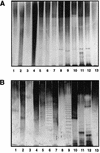Specificity of rabbit antisera against lipopolysaccharide of Acinetobacter
- PMID: 9574685
- PMCID: PMC104808
- DOI: 10.1128/JCM.36.5.1245-1250.1998
Specificity of rabbit antisera against lipopolysaccharide of Acinetobacter
Abstract
Acinetobacter has been reported to be involved in hospital-acquired infections with increasing frequency. However, clinical laboratories still lack simple methods that allow the accurate identification of Acinetobacter strains at the species level. For this study, proteinase K-digested whole-cell lysates from 44 clinical and environmental isolates were investigated by sodium dodecyl sulfate-polyacrylamide gel electrophoresis and immunoblotting with hyperimmune rabbit sera to examine the possibility of developing a serotyping scheme based on the O antigen of Acinetobacter lipopolysaccharide (LPS). The antisera, obtained by immunization of rabbits with 13 of the heat-killed isolates investigated, were characterized by Western blotting and enzyme immunoassay by using proteinase K-digested whole-cell lysates and phenol-water-extracted LPS as antigens. In both assays, the antisera were shown to be highly specific for the homologous antigen. In addition, assignment of Acinetobacter LPS to the smooth or the rough phenotype was shown not to be reliable when it was based only on the results obtained with silver-stained gels. O-antigen reactivity, determined by Western blot analysis, was observed with 11 of the 31 isolates, most of which belonged to the species Acinetobacter baumannii (DNA group 2) and the unnamed DNA group 3. Interestingly, some O antigens were found in a DNA group different from that of the strain used for immunization. The results indicate that O serotyping of Acinetobacter strains is feasible and thus may provide a simple method for the routine identification of these opportunistic pathogens.
Figures



Similar articles
-
Identification of Acinetobacter isolates from species belonging to the Acinetobacter calcoaceticus-Acinetobacter baumannii complex with monoclonal antibodies specific for O Antigens of their lipopolysaccharides.Clin Diagn Lab Immunol. 2002 Jan;9(1):60-5. doi: 10.1128/cdli.9.1.60-65.2002. Clin Diagn Lab Immunol. 2002. PMID: 11777830 Free PMC article.
-
Identification of Acinetobacter baumannii strains with monoclonal antibodies against the O antigens of their lipopolysaccharides.Clin Diagn Lab Immunol. 1999 May;6(3):323-9. doi: 10.1128/CDLI.6.3.323-329.1999. Clin Diagn Lab Immunol. 1999. PMID: 10225830 Free PMC article.
-
Use of a murine O-antigen-specific monoclonal antibody to identify Acinetobacter strains of unnamed genomic species 13 Sensu Tjernberg and Ursing.J Clin Microbiol. 1999 Jun;37(6):1693-8. doi: 10.1128/JCM.37.6.1693-1698.1999. J Clin Microbiol. 1999. PMID: 10325309 Free PMC article.
-
Antigenic differences within Actinobacillus pleuropneumoniae serotype 1.Vet Microbiol. 1994 Feb;38(4):329-49. doi: 10.1016/0378-1135(94)90151-1. Vet Microbiol. 1994. PMID: 8160348
-
Pseudomonas aeruginosa antigens as potential vaccines.FEMS Microbiol Rev. 1997 Nov;21(3):243-77. doi: 10.1111/j.1574-6976.1997.tb00353.x. FEMS Microbiol Rev. 1997. PMID: 9451816 Review.
Cited by
-
Identification of a general O-linked protein glycosylation system in Acinetobacter baumannii and its role in virulence and biofilm formation.PLoS Pathog. 2012;8(6):e1002758. doi: 10.1371/journal.ppat.1002758. Epub 2012 Jun 7. PLoS Pathog. 2012. PMID: 22685409 Free PMC article.
-
Identification of Acinetobacter isolates from species belonging to the Acinetobacter calcoaceticus-Acinetobacter baumannii complex with monoclonal antibodies specific for O Antigens of their lipopolysaccharides.Clin Diagn Lab Immunol. 2002 Jan;9(1):60-5. doi: 10.1128/cdli.9.1.60-65.2002. Clin Diagn Lab Immunol. 2002. PMID: 11777830 Free PMC article.
-
Vaccination with outer membrane complexes elicits rapid protective immunity to multidrug-resistant Acinetobacter baumannii.Infect Immun. 2011 Jan;79(1):518-26. doi: 10.1128/IAI.00741-10. Epub 2010 Oct 25. Infect Immun. 2011. PMID: 20974823 Free PMC article.
-
Generation and serological characterization of murine monoclonal antibodies against O antigens from Acinetobacter reference strains.Clin Diagn Lab Immunol. 2001 Jul;8(4):825-7. doi: 10.1128/CDLI.8.4.825-827.2001. Clin Diagn Lab Immunol. 2001. PMID: 11427435 Free PMC article.
-
O-antigen diversity among Acinetobacter baumannii strains from the Czech Republic and Northwestern Europe, as determined by lipopolysaccharide-specific monoclonal antibodies.J Clin Microbiol. 2001 Jul;39(7):2576-80. doi: 10.1128/JCM.39.7.2576-2580.2001. J Clin Microbiol. 2001. PMID: 11427571 Free PMC article.
References
-
- Bergogne-Berezin E. The increasing significance of outbreaks of Acinetobacter spp.: the need for control and new agents. J Hosp Infect. 1995;30:441–452. - PubMed
-
- Bernards A T, van der Toorn J, van Boven C P A, Dijkshoorn L. Evaluation of the ability of a commercial system to identify Acinetobacter genomic species. Eur J Clin Microbiol Infect Dis. 1996;15:303–308. - PubMed
Publication types
MeSH terms
Substances
LinkOut - more resources
Full Text Sources
Molecular Biology Databases

